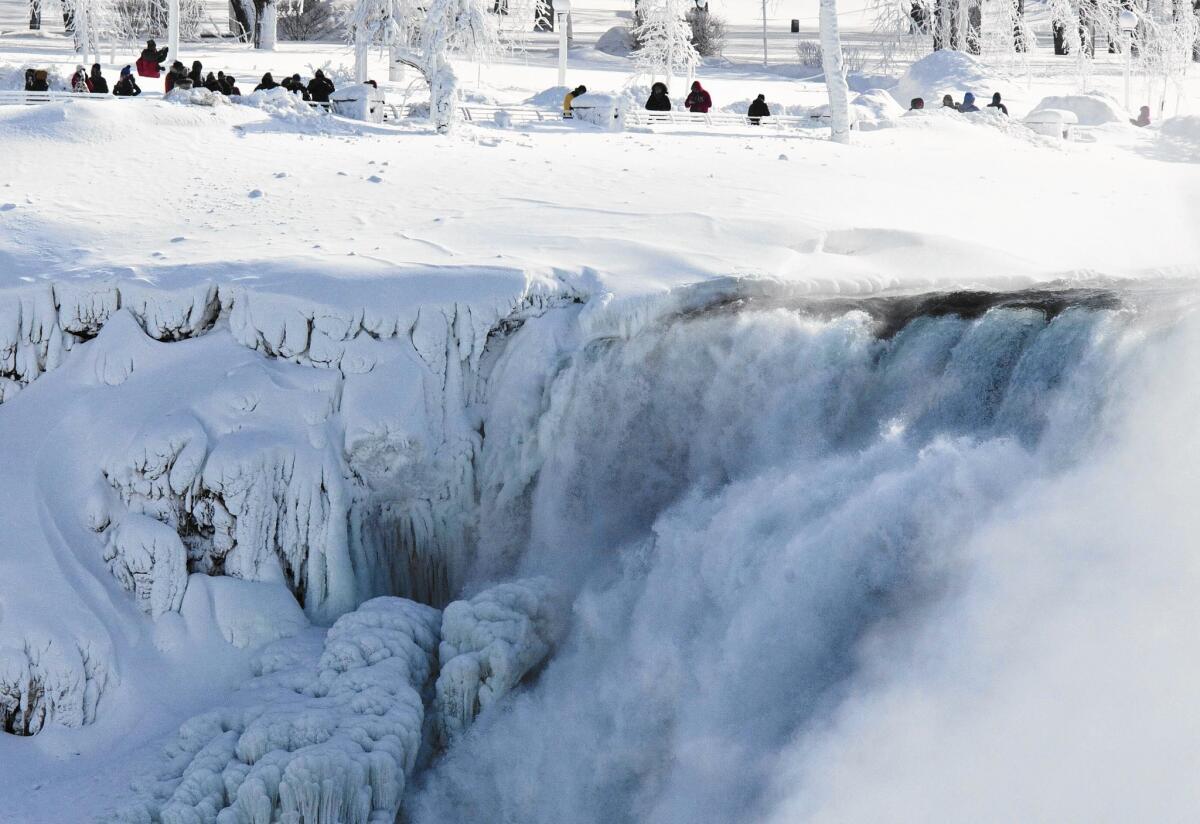Record heat, record snow: The coasts are clearly weather-beaten

- Share via
In the never-ending cross-country rivalry, winter is the West Coast’s prime time to win.
We hold up our sand to the East Coast’s snow, and wiggle our pedicured, flip-flopped toes at clunky, thick-socked boots. On social media, we send out photos of surfers catching sun-spangled waves and smile as we start our postcard-inspired captions with apologies.
This season, however, is one for the record books: heat here, snowfall there.
California is experiencing its warmest recorded winter to date. The average temperature in December and January was 47.8, according to the National Climatic Data Center. That’s 5.1 degrees above the 20th century average for the same months.
On Feb. 8, Bakersfield hit 82 degrees, smashing a nearly century-old record of 77 degrees set in 1917. Last weekend, Southern California — with highs in the mid-80s — was the warmest region in the United States.
Boston, meanwhile, has been buried. With nearly 8 feet of snow so far and no end in sight, it’s already close to the record 107.6 inches that fell in the city over the entire winter of 1995-96.
On Friday, Washington, D.C., hit a record low of 5, three degrees warmer than New York City.
The West Coast’s gloating, though harder to quantify, probably is approaching all-time highs too.
Just look on Twitter or Instagram for hashtags like #socalproblems or #socalwinter, accompanied by photos of jasmine in bloom or people stretched out on beach towels or cannonballing into swimming pools. Comments run along the lines of how tough it is to figure out how to dress because the days start out fall cool and then turn summer hot.
There is, of course, a flip side to this. California remains in a severe drought, with little rainfall in recent weeks.
San Francisco had no rain in January for the first time in 165 years. As for Southern California, “We had a decent amount of rain in December and January, just below what we normally get,” said Ryan Kittell, a meteorologist with the National Weather Service in Oxnard. “But we haven’t had any real rain in February.”
Last week, the National Weather Service’s Hanford station posted a photo from inside Yosemite National Park, 8,100 feet up, with the words, “Looks like August with lack of snow.”
Usually at this time of year, snow appears at elevations of 5,000 to 6,000 feet, station meteorologist Jim Andersen said. What snow we got, he said, melted very fast.
The effect is serious, he said, because Sierra snowpacks help refill reservoirs. Yosemite so far has received about one-fifth of the snow it usually gets. “Which says a lot,” said Andersen, because “that snowpack is basically like a bank that we can go to for water.
“Just like a regular bank account, if you go to take some money out and there’s none there, then you’ve got problems.”
Smaller-than-normal snowfalls in other parts of the West already have caused problems. Squaw Valley and Alpine Meadows ski resorts in Lake Tahoe recently announced that they had to cancel international and national ski cross and snowboard cross competitions scheduled for March.
Bill Patzert, a climatologist with NASA’s Jet Propulsion Laboratory, said the reasons behind the coastal opposition start with Pacific Ocean temperature changes and a phenomenon known as the Ridiculously Resilient Ridge — which on the West Coast pushes the cold, wet air of the jet stream north, away from California and into the Pacific Northwest and Canada.
That cold air then swoops south, he said, creating a polar express. “You get the warm air from the Gulf of Mexico meeting that cold, dry air, so that you get these never-ending blizzards in Boston and Chicago.”
And in a winter of extremes, life on the West Coast and the East Coast couldn’t have been more different Friday.
Across the street from Boston Common, Shea Frasier, 28, smoked a cigarette outside as the temperature gauge in his car read 7 degrees. He’s from Riverside. His girlfriend is in Orange County. When she visited him for Valentine’s Day, “she was miserable the whole time,” he said.
On Friday, back in California, she was about to go camping. If he tried that in Boston, he said, he’d “probably lose five pounds just shivering.”
“I love this city. This is where America was born,” Frasier said. “I just occasionally wonder why I live in a city where the air hurts my face.”
On the Santa Monica Pier, meanwhile, Joe and Claudia Medeiros of San Jose shared a hot dog and explained that — because of the meager snowfall at Lake Tahoe — they’d decided to sun rather than snowboard.
But Claudia said that while she was enjoying the fine weather, she worried about the drought’s impact.
“It’s two polar extremes,” she said of the East and West coasts. “One is getting too much water, and the other not enough.”
With the shortage of rain, down the road the joke could be on us.
“The warm temperatures, of course, we’re gloating on that, right?” Patzert said. “But when summer and fall roll around, the fire danger is going to be astronomical. So when we’re cranking up our AC and rationing our water, and wildfires are raging not only through Southern California but through all of California … who will remember how balmy it was this week?”
We laugh now, but we could be crying later.
Twitter: @latimescitybeat, @ronlin, @RosannaXia
Times staff writers Noah Bierman in Boston and Sarah Parvini, Veronica Rocha, Ruben Vives and Michael Muskal in Los Angeles contributed to this report.
More to Read
Sign up for Essential California
The most important California stories and recommendations in your inbox every morning.
You may occasionally receive promotional content from the Los Angeles Times.
















